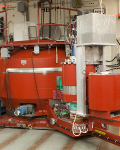A team of Oak Ridge National Laboratory (ORNL) and Indiana University researchers has successfully tested their first Wollaston Prism pair at the High Flux Isotope Reactor (HFIR) beam line HB-1. This test is an important milestone in the Laboratory Directed Research and Development (LDRD) project, “Novel Spin-Echo Techniques for High-Resolution Spectroscopy at HFIR,” and a successful step towards the LDRD project goal of developing a new capability that will allow micro-eV energy-resolution spectroscopy.
Developed by Prof. Roger Pynn’s group at Indiana University, a Wollaston Prism pair provides a novel way to encode the spins of a polarized neutron beam to enable very precise “neutron spin-echo” measurements. In a neutron spin-echo experiment, the neutron spins are encoded by subjecting them to a controlled set of precessions before they scatter from the sample to be studied. The scattered neutron spins are then decoded by subjecting them to a set of precessions that is exactly opposite to the original. This process is called the “spin-echo.” The detailed structure of the spin-echo provides very precise measurements of the dynamical processes occurring in the studied sample.
This project’s ultra-high-resolution spectroscopy application will require the use of two Wollaston prism devices, one at the incident beam of a triple axis spectrometer and a second used on the scattered beam side to encode and decode the neutron spins respectively. When the project is completed, the use of the Wollaston prism pairs in the HB-1 polarized-neutron triple axis spectrometer will enable new capabilities for scientific research at ORNL.
“The idea is that these devices will enable ultra-high-resolution neutron spectroscopy at finite energy transfers,” said Principal Investigator Jaime Fernandez-Baca. “This is similar to what can be done with a technique called “resonance spin-echo” which now can only be performed at European facilities.”
A full assembly test will take place this summer, after developmental testing concludes.
HFIR is a DOE Office of Science User Facility. UT-Battelle manages ORNL for the DOE's Office of Science. The Office of Science is the single largest supporter of basic research in the physical sciences in the United States, and is working to address some of the most pressing challenges of our time. For more information, please visit http://science.energy.gov/.






